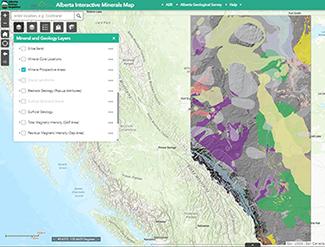The AER is responsible for the safe, efficient, orderly, and environmentally responsible development of energy and mineral resources through our regulatory activities.
In executing its mineral regulatory responsibilities, the AER will continue allocating and conserving water resources, managing public lands, and protecting the environment while providing economic benefits for all Albertans.
Other AER responsibilities include
- developing and administering regulatory instruments and supporting materials, such as rules, directives, and manuals,
- establishing an efficient application review process,
- providing processes for alternative dispute resolution (ADR), hearings, and regulatory appeal, and
- managing industry compliance, enforcement, and monitoring.
Mineral potential
The Government of Alberta has stated it wants to capitalize on Alberta’s mineral potential to become a preferred international producer and supplier of minerals and mineral products. According to Renewing Alberta’s Mineral Future, this will strengthen and diversify the economy, create jobs, and attract investment and address the shift towards a lower-carbon economy.
Mineral types
According to the Mineral Resource Development Act (MRDA), AER-regulated minerals include critical and rare earth minerals. These critical and rare earth minerals can be found throughout Alberta and are used in batteries, portable electronic devices, TVs, toothpaste, buildings, eyeglasses, computers, vehicles, hospital equipment, and many other daily-use items.

Some of the minerals identified in MRDA include the following:
| gold | precious stones | zinc | limestone | phosphate |
| silver | copper | salts (including lithium) | marble | sandstone |
| uranium | iron | sulphur | potash | shale |
| platinum | tin | granite | quartz rock | slate |
The MRDA excludes the following: petroleum, oil, asphalt, bituminous sands, oil sands, natural gas, coal, ammonite shell, sand, gravel, clay, peat, and marl. The AER will continue to regulate petroleum, oil, asphalt, bituminous sands, oil sands, natural gas, and coal under existing relevant legislation.
The regulation of minerals includes brine-hosted mineral resources and rock-hosted mineral resources:
Brine-hosted mineral resources are found in underground saltwater and are mostly extracted through well infrastructure. On the landscape, mineral extraction from brines will look like a traditional oil or gas well operation.
On March 1, 2023, the AER became the life-cycle regulator of brine-hosted minerals.Image
2. Rock-hosted mineral resources are minerals extracted using traditional mining or quarrying techniques. On the landscape, mineral extraction from rock will look like traditional mining operations (e.g., open pit and underground mining).
On February 28, 2024 the AER became the life-cycle regulator of rock-hosted minerals.
Image
Mineral locations
The Alberta Geological Survey (AGS) has been researching minerals within Alberta for decades. This has helped us map minerals within our province and demonstrate the potential for minerals resource development. On March 2, 2023, the AGS initiated the release of data collected as part of one of the largest mineral mapping programs in Alberta’s history. You can review summaries of the project activities and published data in the following magazine, Unlocking Alberta’s Mineral Potential: A Collection of Mineral Data.
A subset of this data is also available to visualize and download from the AGS interactive minerals map*.

Talking to Albertans
Since 2020, the Government of Alberta has sought input on its mineral strategy and the MRDA. This feedback was shared with the AER to inform its engagement work and the development of the future regulatory framework. The AER expanded on the Government of Alberta’s engagement sessions from 2022-2024. Engagement activities spanned the province and included participation from Indigenous communities and groups, industry, and other stakeholders from ranchers to environmentalists to municipalities. Events included:
- public information sessions
- virtual and in-person engagement workshops
- participation at conferences and events
- public comment periods to help inform the final regulatory requirements
Note: The Alberta Energy Regulator is currently seeking feedback on its proposed Specified Enactment Direction 0XX: Rock-Hosted Mine Liability Process (SED). The draft SED outlines liability requirements related to rock-hosted operations. The public comment period is 60 days, starting on February 25, 2025, and ending on April 25, 2025.
Related Information
May 11, 2022 Brine-hosted Minerals Public Information Session:
July 19, 2023, Rock-hosted Minerals Public Information Session
- Video recording: Presentation
- Video recording: Question and Answer Session
- Video demo: Alberta Interactive Minerals Map
- Information Session Slideshow
Finding answers
Based on input from our public engagement sessions, we have compiled answers to commonly asked questions about the regulation of brine-hosted and rock-hosted mineral resources.
If you have questions about a specific matter, you can contact the following:
Report emergencies and operational concerns related to mineral operations
Contact the Energy and Environmental Emergency 24-Hour Response Line: 1-800-222-6514. If reporting emergencies from outside Alberta, Saskatchewan, or B.C., please call 780-422-4505.
Minerals Exploration permits and approvals Exploration@aer.ca
Application submissions, preapplication meeting requests, and related questions MRDAMine.Application@aer.ca
Reports submissions MRDA.Submissions@aer.ca
General inquiries related to minerals Minerals@aer.ca
All other inquires:
Contact our Customer Contact Centre:
Phone: 403-297-8311
Toll-free: 1-855-297-8311
Fax: 403-297-7336
Inquiries@aer.ca
Related links
-
Questions about the regulation of rock-hosted minerals
-
Regulatory Process Overview: Rock-Hosted Mineral Resource Development
-
Guide to Brine-Hosted Resource Development: Directive 090 Application Process
-
Guide to Rock-Hosted Mineral Resource Exploration - Metallic and Industrial Minerals Exploration Regulation (MIMER)
-
Mineral Resource Guide


